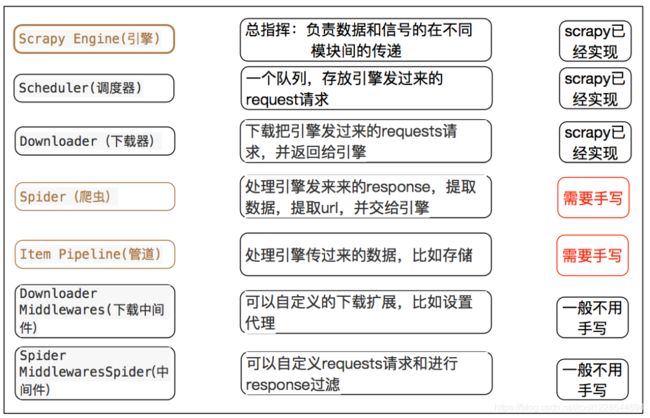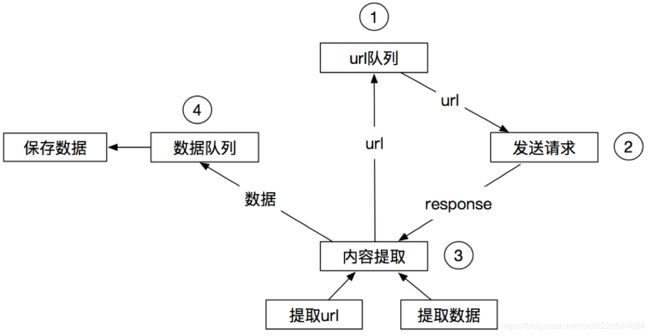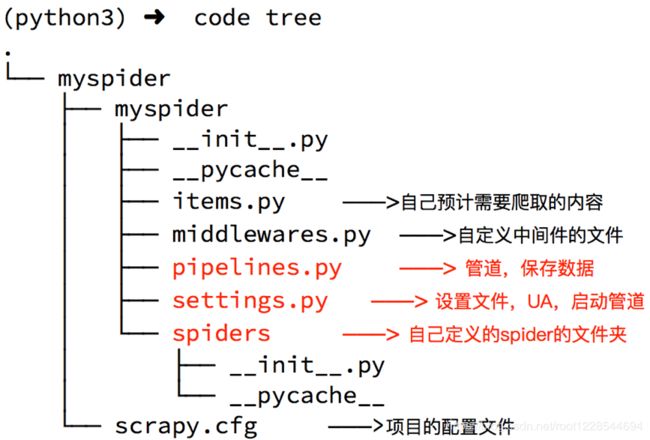数据收集-scrapy爬虫框架(一)
scrapy爬虫框架
- scrapy的概念和流程
- scrapy的流程
- 内置对象
- 模块的具体作用
- 初步使用
- 创建项目
- 创建爬虫
- 完善爬虫
- 保存数据
- 运行
- 总结
- 数据建模与请求
- 建模
- 开发流程总结
- 翻页请求
- 构造Request对象、发送请求
- 网易招聘爬虫
- 代码实现
- scrapy.Request的更多参数
- meta参数的使用
- 小结
scrapy的概念和流程
Scrapy是一个Python编写的开源网络爬虫框架。它是一个被设计用于爬取网络数据、提取结构性数据的框架。
scrapy文档
- 作用:少量的代码,就能够快速的抓取
scrapy的流程
- 爬虫中起始的url构造成request对象–>爬虫中间件–>引擎–>调度器
- 调度器把request–>引擎–>下载中间件—>下载器
- 下载器发送请求,获取response响应---->下载中间件---->引擎—>爬虫中间件—>爬虫
- 爬虫提取url地址,组装成request对象---->爬虫中间件—>引擎—>调度器,重复步骤2
- 爬虫提取数据—>引擎—>管道处理和保存数据
内置对象
- request请求对象:由url method post_data headers等构成
- response响应对象:由url body status headers等构成
- item数据对象:本质是个字典
模块的具体作用

scrapy中每个模块的作用:
引擎(engine):负责数据和信号在不腰痛模块间的传递
调度器(scheduler):实现一个队列,存放引擎发过来的request请求对象
下载器(downloader):发送引擎发过来的request请求,获取响应,并将响应交给引擎
爬虫(spider):处理引擎发过来的response,提取数据,提取url,并交给引擎
管道(pipeline):处理引擎传递过来的数据,比如存储
下载中间件(downloader middleware):可以自定义的下载扩展,比如设置代理ip
爬虫中间件(spider middleware):可以自定义request请求和进行response过滤,与下载中间件作用重复
初步使用
- 安装scrapy
命令:sudo apt-get install scrapy 或:pip/pip3 install scrapy - scrapy项目开发流程
- 创建项目:
scrapy startproject mySpider - 生成一个爬虫:
scrapy genspider baidu baidu.com - 提取数据:
根据网站结构在spider中实现数据采集相关内容 - 保存数据:
使用pipeline进行数据后续处理和保存
创建项目
- 创建scrapy项目的命令:
scrapy startproject <项目名字>
示例:scrapy startproject myspider
创建爬虫
- 命令:
在项目路径下执行:
scrapy genspider <爬虫名字> <允许爬取的域名> - 爬虫名字: 作为爬虫运行时的参数
- 允许爬取的域名: 为对于爬虫设置的爬取范围,设置之后用于过滤要爬取的url,如果爬取的url与允许的域不通则被过滤掉。
- 示例:
cd myspider
scrapy genspider itcast itcast.cn
完善爬虫
- 在/myspider/myspider/spiders/itcast.py中修改内容如下:
import scrapy
class ItcastSpider(scrapy.Spider): # 继承scrapy.spider
# 爬虫名字
name = 'itcast'
# 允许爬取的范围
allowed_domains = ['itcast.cn']
# 开始爬取的url地址
start_urls = ['http://www.itcast.cn/channel/teacher.shtml']
# 数据提取的方法,接受下载中间件传过来的response
def parse(self, response):
# scrapy的response对象可以直接进行xpath
names = response.xpath('//div[@class="tea_con"]//li/div/h3/text()')
print(names)
# 获取具体数据文本的方式如下
# 分组
node_list = response.xpath('//div[@class="tea_con"]//li')
# 遍历所有教师结点
for node in node_list:
# temp={}
#实例化
temp=MyspiderItem()
# xpath方法返回的是选择器对象列表[]
#.extract()用于从选择器对象提取数据,多个值的列表
# 如果xpath结果是只含有一个值的列表,用extract_first()
temp["name"]=node.xpath('./div[2]/h3/text()').extract_first()
temp["title"]=node.xpath('./div[2]/h4/text()')[0].extract()
temp["desc"]=node.xpath('./div[2]/p/text()')[0].extract()
print(temp)
yield temp #爬虫中返回数据通常用yield,翻页方便。return没法继续走
注意:
- scrapy.Spider爬虫类中必须有名为parse的解析
- 如果网站结构层次比较复杂,也可以自定义其他解析函数
- 在解析函数中提取的url地址如果要发送请求,则必须属于allowed_domains范围内,但是start_urls中的url地址不受这个限制,我们会在后续的课程中学习如何在解析函数中构造发送请求
- 启动爬虫的时候注意启动的位置,是在项目路径下启动
- parse()函数中使用yield返回数据,注意:解析函数中的yield能够传递的对象只能是:BaseItem, Request, dict, None
- 定位元素以及提取数据、属性值的方法
解析并获取scrapy爬虫中的数据: 利用xpath规则字符串进行定位和提取
- response.xpath方法的返回结果是一个类似list的类型,其中包含的是selector对象,操作和列表一样,但是有一些额外的方法
- 额外方法extract():返回一个包含有字符串的列表
- 额外方法extract_first():返回列表中的第一个字符串,列表为空没有返回None
- response响应对象的常用属性
- response.url:当前响应的url地址
- response.request.url:当前响应对应的请求的url地址
- response.headers:响应头
- response.requests.headers:当前响应的请求头
- response.body:响应体,也就是html代码,byte类型
- response.status:响应状态码
保存数据
利用管道pipeline来处理(保存)数据
- 在pipelines.py文件中定义对数据的操作
- 定义一个管道类
- 重写管道类的process_item方法
- process_item方法处理完item之后必须返回给引擎
import json
class ItcastPipeline():
# 爬虫文件中提取数据的方法每yield一次item,就会运行一次
# 该方法为固定名称函数
def process_item(self, item, spider):
print(item)
return item
- 在settings.py配置启用管道
ITEM_PIPELINES = {
'myspider.pipelines.ItcastPipeline': 400
}
配置项中键为使用的管道类,管道类使用.进行分割,第一个为项目目录,第二个为文件,第三个为定义的管道类。
配置项中值为管道的使用顺序,设置的数值约小越优先执行,该值一般设置为1000以内。
运行
命令:在项目目录下执行scrapy crawl <爬虫名字>
示例:scrapy crawl itcast
总结
- scrapy的安装:pip install scrapy
- 创建scrapy的项目: scrapy startproject myspider
- 创建scrapy爬虫:在项目目录下执行 scrapy genspider itcast itcast.cn
- 运行scrapy爬虫:在项目目录下执行 scrapy crawl itcast
- 解析并获取scrapy爬虫中的数据:
- response.xpath方法的返回结果是一个类似list的类型,其中包含的是selector对象,操作和列表一样,但是有一些额外的方法
- extract() 返回一个包含有字符串的列表
- extract_first() 返回列表中的第一个字符串,列表为空没有返回None
- scrapy管道的基本使用:
- 完善pipelines.py中的process_item函数
- 在settings.py中设置开启pipeline
- response响应对象的常用属性
- response.url:当前响应的url地址
- response.request.url:当前响应对应的请求的url地址
- response.headers:响应头
- response.requests.headers:当前响应的请求头
- response.body:响应体,也就是html代码,byte类型
- response.status:响应状态码
数据建模与请求
建模
- 建模原因
- 定义item即提前规划好哪些字段需要抓,防止手误,因为定义好之后,在运行过程中,系统会自动检查
- 配合注释一起可以清晰的知道要抓取哪些字段,没有定义的字段不能抓取,在目标字段少的时候可以使用字典代替
- 使用scrapy的一些特定组件需要Item做支持,如scrapy的ImagesPipeline管道类
- 建模方法:在items.py文件中定义要提取的字段:
class MyspiderItem(scrapy.Item):
name = scrapy.Field() # 讲师的名字
title = scrapy.Field() # 讲师的职称
desc = scrapy.Field() # 讲师的介绍
- 使用模板类
模板类定义以后需要在爬虫中导入并且实例化,之后的使用方法和使用字典相同
job.py:
from myspider.items import MyspiderItem # 导入Item,注意路径
...
def parse(self, response)
item = MyspiderItem() # 实例化后可直接使用
item['name'] = node.xpath('./h3/text()').extract_first()
item['title'] = node.xpath('./h4/text()').extract_first()
item['desc'] = node.xpath('./p/text()').extract_first()
print(item)
注意:
- from myspider.items import MyspiderItem这一行代码中 注意item的正确导入路径,忽略pycharm标记的错误
- python中的导入路径要诀:从哪里开始运行,就从哪里开始导入
开发流程总结
- 创建项目
scrapy startproject 项目名 - 明确目标
在items.py文件中进行建模 - 创建爬虫
3.1 创建爬虫
scrapy genspider 爬虫名 允许的域
3.2 完成爬虫
修改start_urls
检查修改allowed_domains
编写解析方法 - 保存数据
在pipelines.py文件中定义对数据处理的管道
在settings.py文件中注册启用管道
翻页请求
- requests模块实现翻页请求:
- 找到下一页的URL地址
- 调用requests.get(url)
- scrapy实现翻页的思路:
- 找到下一页的url地址
- 构造url地址的请求对象,传递给引擎
构造Request对象、发送请求
实现方法:
- 确定url地址
- 构造请求,scrapy.Request(url,callback)
- callback:指定解析函数名称,表示该请求返回的响应使用哪一个函数进行解析
- 把请求交给引擎:yield scrapy.Request(url,callback)
网易招聘爬虫
通过爬取网易招聘的页面的招聘信息,学习如何实现翻页请求
地址:https://hr.163.com/position/list.do
思路分析:
- 获取首页的数据
- 寻找下一页的地址,进行翻页,获取数据
注意:
1. 可以在settings中设置ROBOTS协议
# False表示忽略网站的robots.txt协议,默认为True
ROBOTSTXT_OBEY = False
2. 可以在settings中设置User-Agent:
# scrapy发送的每一个请求的默认UA都是设置的这个User-Agent
USER_AGENT = 'Mozilla/5.0 (Macintosh; Intel Mac OS X 10_12_5) AppleWebKit/537.36 (KHTML, like Gecko) Chrome/59.0.3071.115 Safari/537.36'
代码实现
......
# 提取下一页的href
next_url = response.xpath('//a[contains(text(),">")]/@href').extract_first()
# 判断是否是最后一页
if next_url != 'javascript:void(0)':
# 构造完整url
url = 'https://hr.163.com/position/list.do' + next_url
# 构造scrapy.Request对象,并yield给引擎
# 利用callback参数指定该Request对象之后获取的响应用哪个函数进行解析
yield scrapy.Request(url, callback=self.parse)
......
scrapy.Request的更多参数
scrapy.Request(url[,callback,method="GET",headers,body,cookies,meta,dont_filter=False])
参数解释
- 中括号里的参数为可选参数
- callback:表示当前的url的响应交给哪个函数去处理
- meta:实现数据在不同的解析函数中传递,meta默认带有部分数据,比如下载延迟,请求深度等
- dont_filter:默认为False,会过滤请求的url地址,即请求过的url地址不会继续被请求,对需要重复请求的url地址可以把它设置为Ture,比如贴吧的翻页请求,页面的数据总是在变化;start_urls中的地址会被反复请求,否则程序不会启动
- method:指定POST或GET请求
- headers:接收一个字典,其中不包括cookies
- cookies:接收一个字典,专门放置cookies
- body:接收json字符串,为POST的数据,发送payload_post请求时使用(在下一章节中会介绍post请求)
meta参数的使用
meta的作用:meta可以实现数据在不同的解析函数中的传递。
在爬虫文件的parse方法中,提取详情页增加之前callback指定的parse_detail函数:
def parse(self,response):
...
yield scrapy.Request(detail_url, callback=self.parse_detail,meta={"item":item})
...
def parse_detail(self,response):
#获取之前传入的item
item = resposne.meta["item"]
特别注意
- meta参数是一个字典
- meta字典中有一个固定的键proxy,表示代理ip,关于代理ip的使用我们将在scrapy的下载中间件的学习中进行介绍
小结
- 完善并使用Item数据类:
- 在items.py中完善要爬取的字段
- 在爬虫文件中先导入Item
- 实力化Item对象后,像字典一样直接使用
- 构造Request对象,并发送请求:
- 导入scrapy.Request类
- 在解析函数中提取url
- yield scrapy.Request(url, callback=self.parse_detail, meta={})
- 利用meta参数在不同的解析函数中传递数据:
- 通过前一个解析函数 yield scrapy.Request(url, callback=self.xxx, meta={}) 来传递meta
- 在self.xxx函数中 response.meta.get(‘key’, ‘’) 或 response.meta[‘key’] 的方式取出传递的数据
网易项目
提取岗位及岗位职责要求,meta传递参数
wangyi/spiders/job.py
import scrapy
from wangyi.items import WangyiItem
class JobSpider(scrapy.Spider):
name = 'job'
# 2.检查修改allowed_
allowed_domains = ['163.com']
# 1.修改起始start_url
start_urls = ['https://hr.163.com/position/list.do']
def parse(self, response):
# 提取数据
# 获取所有职位结点列表
node_list = response.xpath('//tbody/tr')
# node_list=response.xpath('//*[@class="position-tb"]/tbody/tr')
print(len(node_list))
# 遍历结点列表,过滤
for num, node in enumerate(node_list):
# print(num,node)
# 设置过滤条件
if num % 2 == 0:
item = WangyiItem()
item["name"] = node.xpath('./td[1]/a/text()').extract_first()
# response.urljoin()用于拼接相对路径的url,可以理解成自动补全
# item['link']=response.urljoin(node.xpath('./td[1]/a/text()').extract_first())
item["link"] = 'https://hr.163.com/' + node.xpath('./td[1]/a/@href').extract_first()
item["depart"] = node.xpath('./td[2]/text()').extract_first()
item["category"] = node.xpath('./td[3]/text()').extract_first()
item["type"] = node.xpath('./td[4]/text()').extract_first()
item["address"] = node.xpath('./td[5]/text()').extract_first()
item["num"] = node.xpath('./td[6]/text()').extract_first().strip() # 用于去除字符串中的空格
item["date"] = node.xpath('./td[7]/text()').extract_first()
# yield item
# 构建详情页面的请求
yield scrapy.Request(
url=item['link'],
callback=self.parse_deatil,
meta={'item': item}
)
# 模拟翻页
part_url = response.xpath('/html/body/div[2]/div[2]/div[2]/div/a[last()]/@href').extract_first()
# 判断终止条件
if part_url != 'javascript:void(0)':
next_url = response.urljoin(part_url)
yield scrapy.Request(
url=next_url,
callback=self.parse
)
def parse_deatil(self, response):
# print(response.meta['item'])
# 提取剩余字段的数据
item = response.meta['item']
item['duty'] = response.xpath(
'/html/body/div[2]/div[2]/div[1]/div/div/div[2]/div[1]/div/text()').extract() # 数据为多个
item['require'] = response.xpath(
'/html/body/div[2]/div[2]/div[1]/div/div/div[2]/div[2]/div/text()').extract() # 数据为多个
# print(item)
# 返回给引擎
yield item
wangyi/items.py
import scrapy
class WangyiItem(scrapy.Item):
# define the fields for your item here like:
name = scrapy.Field()
link = scrapy.Field()
depart = scrapy.Field()
category = scrapy.Field()
type = scrapy.Field()
address = scrapy.Field()
num = scrapy.Field()
date = scrapy.Field()
duty = scrapy.Field()
require = scrapy.Field()
wangyi/pipeline.py
import json
class WangyiPipeline:
def __init__(self):
self.file=open('wangyi.json','w')
def process_item(self, item, spider):
item=dict(item)
str_data=json.dumps(item,ensure_ascii=False)+',\n'
self.file.write(str_data)
return item


